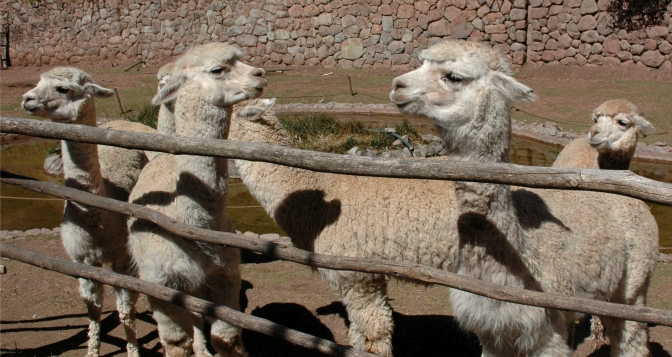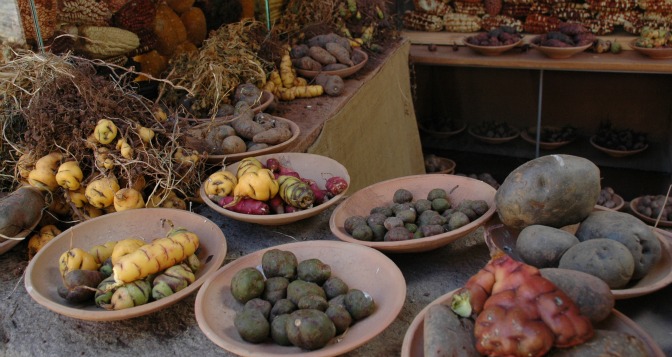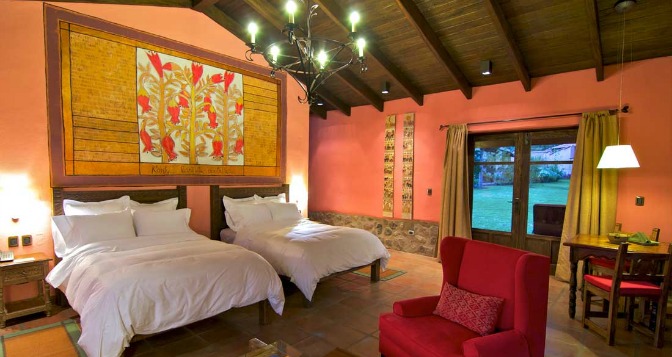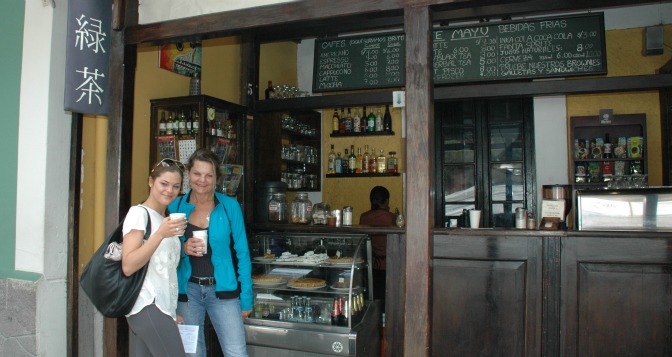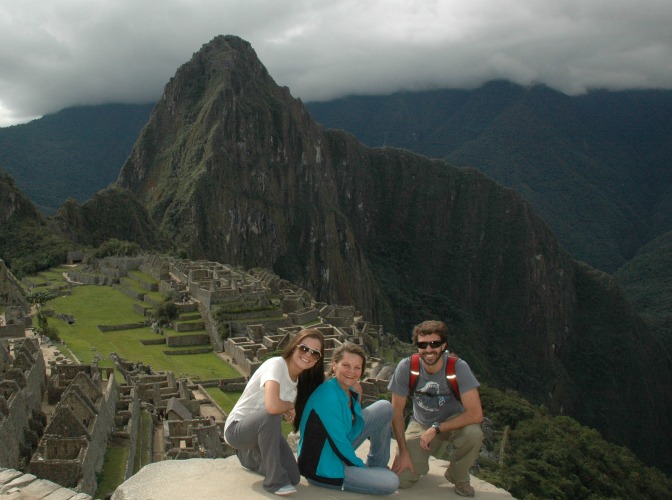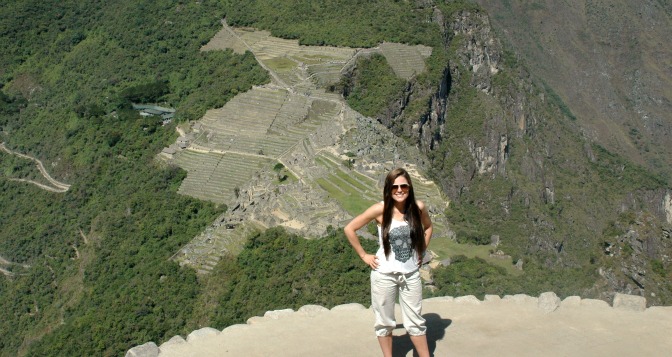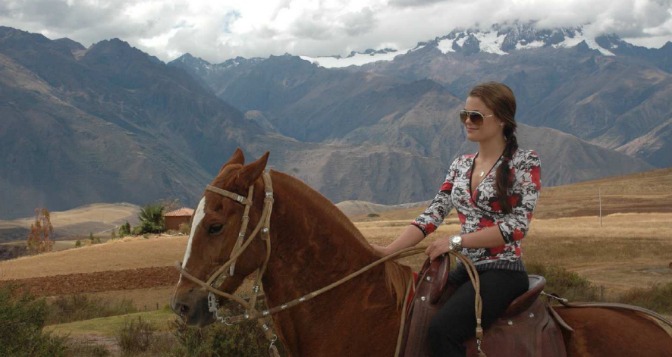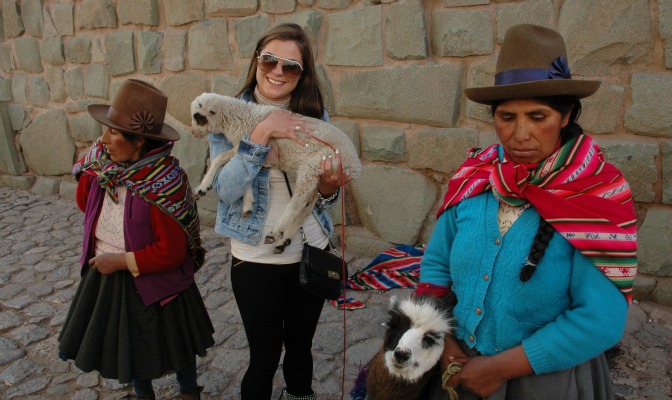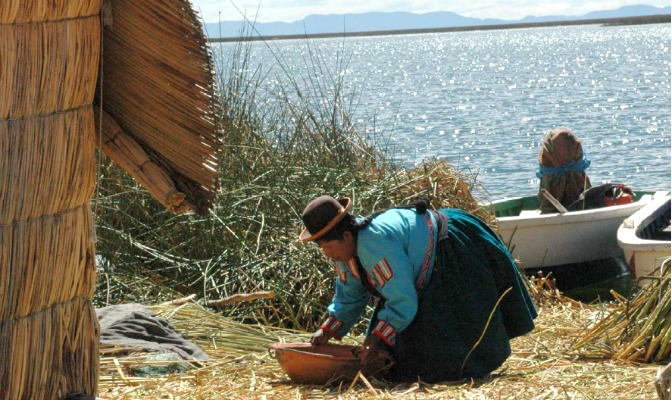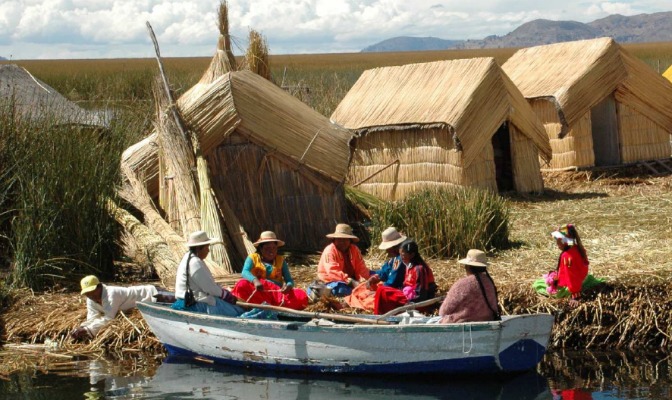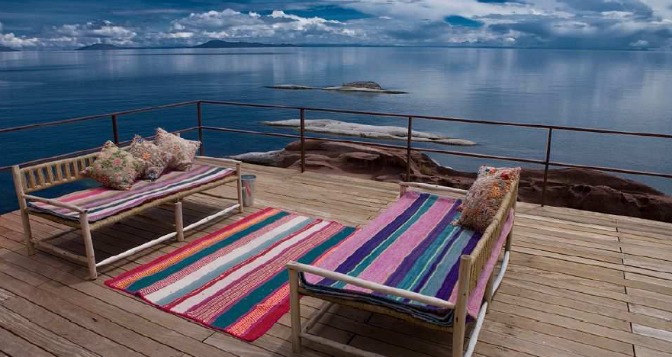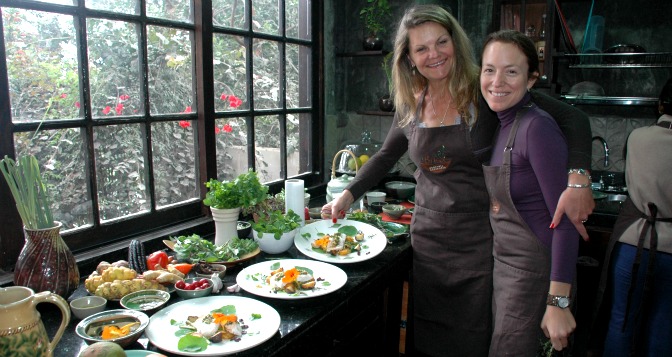Just an hour and half flight from Lima, Cusco, the ancient capital of the Inca with its 400,000 residents, sits at 10,900 feet above sea level in glorious winter sunshine and surrounded by the Andes. Feeling a little breathless on arrival, we are immediately tempted with a cup of tea made from cocoa leaves, the local antidote for altitude sickness.
We drive to the El Valle Sagrado (the Sacred Valley), the area between Cusco and Machu Picchu, thankfully 1,600 ft below that of Cusco. A fertile, sunny valley loved by the Inca and strewn with their citadels at Pisac and Ollantaytambo. Throughout the drive are small traditional Andean towns, bustling Indian markets, weavers and farmers. Our route takes us by a llama and alpaca farm – cute but smelly and aggressive spitters. Maddi purchases a splendid pair of alpaca slippers. There is also vicuña, the neck fur of which is the finest fiber on earth, softer than cashmere! We lunch at a gorgeous old Hacienda packed with religious artifacts and roaring fireplaces – our Canadian blood does not need fireplaces but locals think 20 C is cold. Afterwards we are thankful that we ate where we did – as we pass the local roadside lunch hot-spots, there are guinea pigs roasted on sticks! We continue to Sol y Luna, our heavenly hotel for the next few days. Cobblestone pathways connect 28 individual casitas, all with walkouts to immaculate acres of gardens, decor is country-Peruvian with all the modern conveniences – heated floors, heated towels, Wi-Fi, stunning marble bathrooms and a roaring fireplace in the bedroom. Dinner across the gardens in lovely Wayra restaurant with our fabulous French-born hotelier.
The following day we visit the Incan village of Ollantaytambo, ancient ruins with stonework, narrow cobblestoned streets and pre-Columbian courtyards. A ceremonial site and scene of battles between the Inca and Spanish conquerors, we are lucky to stumble upon a battle re-enactment. Hundreds of people are dressed in traditional clothes on the terraces and there is music and much flag-waving. Lunch today is a Pachamanca – a typical and ancient Peruvian cooking technique in an earth oven where native ingredients of tubers, vegetables and meats are wrapped in local herbs are prepared using wood-heated stones. There are 3,000 varieties of potatoes in Peru!
Machu Picchu – Birds, Orchids and Trains
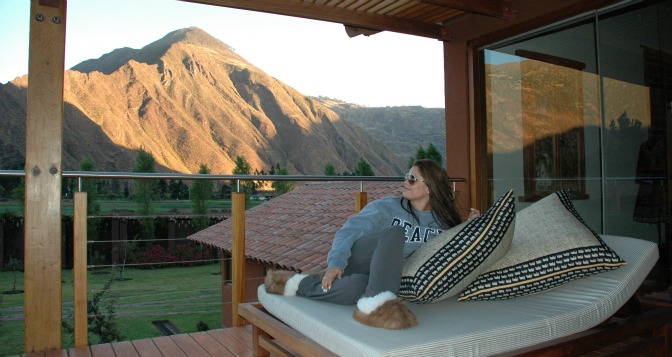 You are only allowed hand luggage on the trains that run the valley up to Machu Picchu – a relief as we leave our luggage behind and depart early with just a change of clothes. We stop for pre-train coffee in Ollaytantambo along with a breakfast gooseberry cheesecake … only on vacation can you eat like this and not hate yourself. We depart for the hour and half hour ride, surrounded by snow-capped mountains and the famous 42 km long Inca Trail running alongside the river beside us. The rail line has been ferrying folks up to the ruins since 1935 and is still the only way to get there other than walking. At KM, 104 day hikers disembark and head off for the final leg of the Inca Trail – a 6-hour trek to the Sun Gate and Machu Picchu. Unfortunately, we couldn’t get permits on late notice so we make do with hanging out of the train window relishing one beautiful view after another. We are in cloud forest – epiphytes, orchids, bromeliads, parrots, the deepest canyons, sheerest mountains, and an ever wilder river beside us. We arrive far too quickly into Aquas Calientes, the village which has grown up in a narrow gorge to serve visitors to the ruin, and go immediately to the bus station for the 25 minute bus ride to ruins.
You are only allowed hand luggage on the trains that run the valley up to Machu Picchu – a relief as we leave our luggage behind and depart early with just a change of clothes. We stop for pre-train coffee in Ollaytantambo along with a breakfast gooseberry cheesecake … only on vacation can you eat like this and not hate yourself. We depart for the hour and half hour ride, surrounded by snow-capped mountains and the famous 42 km long Inca Trail running alongside the river beside us. The rail line has been ferrying folks up to the ruins since 1935 and is still the only way to get there other than walking. At KM, 104 day hikers disembark and head off for the final leg of the Inca Trail – a 6-hour trek to the Sun Gate and Machu Picchu. Unfortunately, we couldn’t get permits on late notice so we make do with hanging out of the train window relishing one beautiful view after another. We are in cloud forest – epiphytes, orchids, bromeliads, parrots, the deepest canyons, sheerest mountains, and an ever wilder river beside us. We arrive far too quickly into Aquas Calientes, the village which has grown up in a narrow gorge to serve visitors to the ruin, and go immediately to the bus station for the 25 minute bus ride to ruins.
Nothing can prepare you for Machu Picchu. Breathtaking does not even come close. We walk the ruins and after three hours, we did not want to leave. You are literally in a cathedral of mountains among the ruins of a community that so clearly worshiped nature, the landscape and the gods – who actually somehow seemed to be closer up there. We take one of the last busses down and wander the streets of the village en route to the Inkaterra Pueblo Hotel – our wonderful hotel for two nights. Set on 14 acres and boasting 300 varieties of orchids and countless varieties of hummingbirds, the lodge is a series of cottages and casitas with tiled floors and thatched roofs. Dinner is overlooking the Urubamba River and a much deserved soak in the hot tub is enjoyed before an early night to bed.
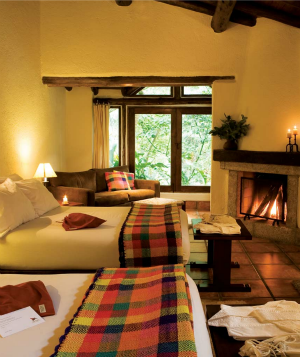
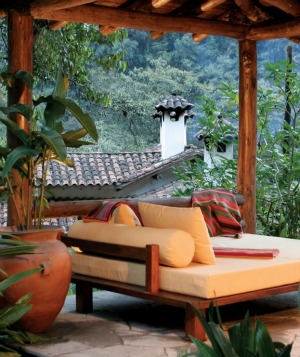 The next day we are up at the crack of dawn – we have committed to climb Huayna Picchu Mountain, the peak that presides over Machu Picchu in photographs … yes there is a trail that leads all the way to the top. We have long ago secured permits and join the line of only 200 people who are allowed up at 10:00am – the first 200 have been and gone at 7am already. I have vertigo and doubt I will make it – our guide assures me I will not make it … which makes me want to make it. The trail is a series of stairs, switchbacks, and steep verticals, all very narrow – in a few particularly vertigo-ish places there are railings and cables to hold onto. After much huffing, puffing and water chugging we reach the top with a bird’s eye view of tiny little Machu Picchu below. Awestruck again we sit for a while and soak it up.
The next day we are up at the crack of dawn – we have committed to climb Huayna Picchu Mountain, the peak that presides over Machu Picchu in photographs … yes there is a trail that leads all the way to the top. We have long ago secured permits and join the line of only 200 people who are allowed up at 10:00am – the first 200 have been and gone at 7am already. I have vertigo and doubt I will make it – our guide assures me I will not make it … which makes me want to make it. The trail is a series of stairs, switchbacks, and steep verticals, all very narrow – in a few particularly vertigo-ish places there are railings and cables to hold onto. After much huffing, puffing and water chugging we reach the top with a bird’s eye view of tiny little Machu Picchu below. Awestruck again we sit for a while and soak it up.
Yes! Machu Picchu!
Tiny little Machu Picchu down below …
Cuzco – Paso Horses, Salt Mines, Chocolate and Ladies with Lambs
We take an early train back to Sacred Valley for some horseback riding in the Andes. Peruvian Paso horses have a gait all of their own and our chalan (cowboy) is lovely. Maddi’s horse does not seem to keen on her but settles after the first stop. We ride from the village of Moray to Maras, through canyons and farms, surrounded by snow-capped mountains and golden fields of altiplano crops. A sheltered lunch in an abandoned farmhouse with a spread fit for Inca royalty – steamed potatoes with a special sauce are served hot, local cheeses, salamis, delicious plums … the chalan eats so many potatoes I think he might need a nap – apparently his mother made them…cute. Late afternoon we visit the Maras “salt mines” – 3,000 or so small pools filled every three days during the dry season with salty water from a natural under-mountain salt water spring and then harvested into beautiful pink salt – the same pink salt that we covet in the fancy gourmet stores!
Cuzco – Chocolate and Guinea Pigs
We overnight in Cuzco at the luxurious Inkaterra La Casona in another fabulous room on a quiet square in small hotel. We rendezvous with an English family who we have met on road and an evening of noisy fun and dinner at “Ciccolina”. The food is fantastic and the teens even gather the courage to eat guinea pig! The adults happily stick to beef and good wine… Maddi and English Cameron hit up some local bars – Cuzco has great nightlife including, Museum of Pisco, a bar which serves hundreds of cocktails with the national drink as main ingredient. Next day we do a walking tour and a fabulous wander through the main market, bartering at every step and then up to Sacsayhuaman, the Inca site that overlooks the city. We spend a hilarious afternoon making chocolate, from bean to box and all the steps in between. We pick, we roast, we crush, we drink it hot and we make chocolates spiced with chilli and pink salt. Dinner at fabulous Senzo – fantastic tasting menu. Note to self: Must really stop eating.
Lake Titikaka and Uros – Reed people of the highest navigable lake in the World
We fly from Cuzco one short hour over the cloudy Andes and through arid valley to Juliaca – the closest airport to Lake Titikaka, Puno and onward to Bolivia. Two hours later we arrive at mystical Hotel Titilaka perched on spit of red rocks at the edge of lake. Altitude is 12,500 ft., but we do not feel it. Hotel is funky and luxurious with wild art work, bright colours and everywhere nooks with fireplaces for sitting back to admire the views. The dining room serves all manner of Peruvian delicacies – quinoa soufflé, soups and local trout done several ways. We leave after breakfast by car and then boat to the Uros National Reserve, a swath of lake protected and home to the Uros people who for hundreds of years have lived on man-made islands made from metres of packed reeds. Reed beds are cut as needed and anchored to stable shallow water. The people fish in reed canoes or sometimes more substantial boats. In his effort to prove that South Americans could have settled Polynesia, Norwegian explorer Thor Hyderhal used one of these boats to sail 8,000 km across the Pacific during his famous Kon-tiki expedition in 1947.
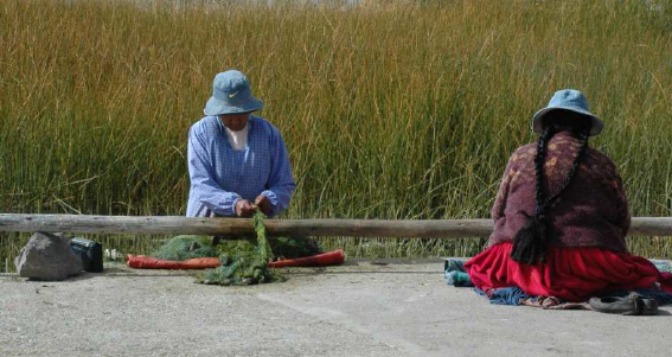 We return to the lodge and spend the afternoon kayaking through the clear waters. We manage a short bike ride to the village but altitude gets the better of us. Another boat trip out to the Tranquile Island – ancient home of weavers and museum of culture. The islands of the Sun and the Moon lie just across the water in Bolivian territory but unfortunately we don’t have time to visit.
We return to the lodge and spend the afternoon kayaking through the clear waters. We manage a short bike ride to the village but altitude gets the better of us. Another boat trip out to the Tranquile Island – ancient home of weavers and museum of culture. The islands of the Sun and the Moon lie just across the water in Bolivian territory but unfortunately we don’t have time to visit.
Lima – Food and Friends
We leave for the last few days in Lima. Our hotel simply called “B” but should be A+ – it is perfectly located in residential area of artists and galleries, fabulous rooms and great little bar, dining room and rooftop patio with views of the Pacific. Dinner at “Central” with the hotter than molten lava chef, Virgilio Martinez at the helm. He had me at the five types of bread served to start the meal … along with pink salt butter. Many ingredients from the Amazon and the sea all perfectly served at our table which happens to be beside his office, a glass box in the restaurant … I think there are at least 100 containers of what seems to be salt on the shelves?
We enjoy a tour of Lima – the Spanish Vice-Royal capital of South America – with its remarkable colonial mansions, churches and squares. The districts of San Isidro, Miraflores and Barranco are scattered with museums of anthropology, ceramics, textiles and silverwork of pre-Columbian cultures. Lima has nine million inhabitants, traffic is gridlock but the vibe is pure latino and fantastic. There are cafés, chic shopping and a population who is united in their pursuit of great food – which we have chance to share in. We spend the remainder of our day with a chef in a private house in the Lurin, an hour from Lima, visiting organic farms and cooking a truly delicious lunch. En route back to the hotel, we stop at the home of a private textile collector where we chat for an hour – he’s an expat who came to Peru for a holiday 30 years ago and never left. I, on the other hand, have to leave … early tomorrow.

